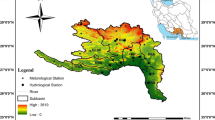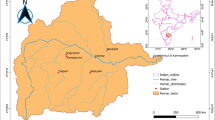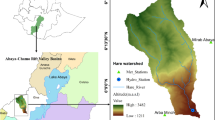Abstract
It is critical to assess drought risk probability based on a really spatio-temporal continuum identification and characterization method, which is of great importance for drought resistance, planning, and management of water resource as well as agricultural production. Therefore, the major motivation of this study is to identify and characterize hydrological drought events in a three-dimensional framework and further assess the potential drought risk probability in a multivariate framework in the Luanhe River basin during 1961–2011. The study adopts a really spatio-temporal continuum identification method to characterize drought, and copula functions for multivariate risk probability assessment of hydrological drought. First, the Soil and Water Assessment Tool (SWAT) model is used to simulate the watershed runoff and the cubic spline interpolation method is used to obtain the gridded data sets. Second, the Standardized Runoff Index (SRI) and the three-dimensional identification method are employed to identify hydrological drought. Third, according to three drought parameters of drought severity (S), duration (D), and affect area (A), the marginal distribution, bivariate, and trivariate joint distribution are constructed, and the optimal ones are selected based on different evaluation methods of goodness-of-fit. Fourth, based on the derived marginal and joint distributions, drought risk probability is fully assessed. Results indicate that: (1) SWAT model is a reliable tool to simulate the watershed hydrologic processes; (2) the three-dimensional identification method used in this study is robust and efficient; (3) the optimal marginal distributions for S, D, and A are GEV, GEV, and lognormal distribution; the optimal bivariate copula function for S-D, S-A, and D-A are Joe, Gumbel, and Joe copula; and the optimal trivariate copula function for S-D-A is Nested Gumbel copula; (4) return periods of the first five most serious drought events are 80, 75, 46, 45, and 40 years, respectively; (5) to completely characterize the spatio-temporal variability of hydrological drought, it is necessary to completely consider the three characteristic variables of S, D, and A.



















Similar content being viewed by others
References
Abdul Rauf UF, Zeephongseku P (2014) Copula based analysis of rainfall severity and duration: a case study. Theor Appl Climatol 115(1):153–166
Ahmadalipour A, Moradkhani H, Demirel MC (2017) A comparative assessment of projected meteorological and hydrological droughts: elucidating the role of temperature. J Hydrol 553:785–797
Andreadis KM, Clark EA, Wood AW, Hamlet AF, Lettenmaier DP (2005) Twentieth-century drought in the conterminous United States. J Hydrometeorol 6(6):985–1001
Chang JX, Li YY, Wang YM, Yuan M (2016) Copula-based drought risk assessment combined with an integrated index in the Wei River Basin, China. J Hydrol 540:824–834
CMA (2011) Yearbook of meteorological disasters in China, 2010. In: China Meteorological Press in Chinese
Fisher NI, Switzer P (1985) Chi-plots for assessing dependence. Biometrika 72:253–265
Fleig AK, Tallaksen LM, Hisdal H, Hannah DM (2011) Regional hydrological drought in north-western Europe: linking a new regional drought area index with weather types. Hydrol Process 25(7):1163–1179
Fu G, Butler D (2014) Copula-based frequency analysis of overflow and flooding in urban drainage systems. J Hydrol 510(3):49–58
Genest C, Favre AC (2007) Everything you always wanted to know about copula modeling but were afraid to ask. J Hydrol En 12(4):347–368
Genest C, Rémillard B, Beaudoin D (2009) Goodness-of-fit tests for copulas: a review and a power study. Insur Math Econ 44(2):199–213
Gocic M, Trajkovic S (2014) Spatiotemporal characteristics of drought in Serbia. J Hydrol 510:110–123
Guo E, Liu X, Zhang J, Wang Y, Wang C, Wang R, Li DJ (2017) Assessing spatiotemporal variation of drought and its impact on maize yield in Northeast China. J Hydrol 553:231–247
Haihe River Water Conservancy Commission, MWR (2009) Flood and drought disasters in the Haihe River basin. Tianjin science and technology press, Tianjin
Hosking JRM (1990) L-moments: analysis and estimation of distributions using linear combinations of order statistics. J R Stat So Ser B 52(1):105–124
Khedun CP, Mishra AK, Singh VP, Giardino JR (2014) A copula-based precipitation forecasting model: investigating the interdecadal modulation of ENSO’s impacts on monthly precipitation. Water Resou Res 50(1):580–600
Lloyd-Hughes B (2012) A spatio-temporal structure-based approach to drought characterisation. Int J Climatol 32(3):406–418
Maliehe M, Mulungu DMM (2017) Assessment of water availability for competing uses using SWAT and WEAP in South Phuthiatsana catchment, Lesotho. Phys Chem Earth 100:305–316
Min SK, Kwon WT, Park EH, Choi Y (2003) Spatial and temporal comparisons of droughts over Korea with East Asia. Int J Climatol 23(2):223–233
Nelsen RB (2006) An introduction to copulas. Springer, New Yor
Reddy MJ, Ganguli P (2012) Application of copulas for derivation of drought severity–duration–frequency curves. Hydrol Process 26(11):1672–1685
Reddy MJ, Ganguli P (2013) Spatio-temporal analysis and derivation of copula-based intensity-area-frequency curves for droughts in western Rajasthan (India). Stoch Env Res Risk Assess 27:1975–1989
Salas JD, Fu C, Cancelliere A, Dustin D, Bode D, Pineda A, Vincent E (2005) Character-izing the severity and risk of drought in the Poudre River, Colorado. J Water Res Pl-ASCE 131(5):383–393
Salvadori G, Michele CD (2010) Multivariate multiparameter extreme value models and return periods: a copula approach. Water Resour Res 46(10):219–233
Shiau JT, Shen HW (2001) Recurrence analysis of hydrologic droughts of differing severity. J Water Res Pl-ASCE 127:30–40
Shiau JT (2006) Fitting drought duration and severity with two-dimensional copulas. Water Resour Manag 20(5):795–815
Shukla S, Wood AW (2008) Use of a standardized runoff index for characterizing hydrologic drought. Geophys Res Lett 35(2):226–236
Sklar M (1959) Fonctions de répartition à n dimensions et leurs marges. Université Paris 8, Paris
Song S, Singh VP (2010) Meta-elliptical copulas for drought frequency analysis of periodic hydrologic data. Stoch Env Res Risk Assess 24(3):425–444
Song X, Li L, Fu G, Li J, Zhang A, Li W, Zhang K (2013) Spatial-temporal variations of spring drought based on spring-composite index values for the Songnen plain, Northeast China. Theor App Climatol 16(3–4):371–384
Trinh T, Ishida K, Kavvas ML, Ercan A, Carr K (2017) Assessment of 21st century drought conditions at Shasta Dam based on dynamically projected water supply conditions by a regional climate model coupled with a physically-based hydrology model. Science Total Environ 586:197–205
Tsai TL, Yang JC (2005) Kinematic wave modeling of overland flow using characteristics method with cubic-spline interpolation. Adv Water Resour 28(7):661–670
Tsakiris G, Kordalis N, Tigkas D, Tsakiris V, Vangelis H (2016) Analysing drought severity and areal extent by 2D Archimedean copulas. Water Resour Manag 30:1–13
Wang AH, Lettenmaier DP, Sheffield J (2011) Soil moisture drought in China, 1950-2006. J Clim 24(13):3257–3271
Wilhite DA, Svoboda MD, Hayes MJ (2006) Understanding the complex impacts of drought: a key to enhancing drought mitigation and preparedness. Water Resour Manag 21:763–774
Wong G, Van Lanen HAJ, Torfs PJJF (2013) Probabilistic analysis of hydrological drought characteristics using meteorological drought. Hydrol Sci J-Journal des Sciences Hydrologiques 58(2):253–270
Xu K, Yang D, Yang H, Li Z, Qin Y, Shen Y (2015) Spatio-temporal variation of drought in China during 1961–2012: a climatic perspective. J Hydrol 526:253–264
Yevjevich V (1967) An objective approach to definitions and investigations of continental hydrologic droughts. Colorado State University
Zarch MA, Sivakumar B, Sharma A (2015) Droughts in a warming climate: a global assessment of standardized precipitation index (SPI) and reconnaissance drought index (RDI). J Hydrol 526:183–195
Zhang DD, Yan DH, Lu F, Wang YC, Fen J (2015) Copula-based risk assessment of drought in Yunnan province, China. Nat Hazards 75(3):2199–2220
Zhang Q, Xiao M, Singh VP, Chen X (2013) Copula-based risk evaluation of hydrological droughts in the East River basin, China. Stoch Env Res Risk Assess 27:1397–1406
Acknowledgements
The authors sincerely acknowledge the insightful comments and corrections of editors and reviewers.
Funding
This investigation is supported by the Natural Science Foundation of China (Nos. 51579169, 51479130, 51279123, 51179117) and the National Key R & D Program of China (Grant No. 2016YFC0401407).
Author information
Authors and Affiliations
Corresponding author
Ethics declarations
Conflict of interest
The authors declare that they have no competing interests.
Additional information
Publisher’s note
Springer Nature remains neutral with regard to jurisdictional claims in published maps and institutional affiliations.
Electronic supplementary material
ESM 1
(DOC 647 kb)
Rights and permissions
About this article
Cite this article
Chen, X., Li, Fw., Li, Jz. et al. Three-dimensional identification of hydrological drought and multivariate drought risk probability assessment in the Luanhe River basin, China. Theor Appl Climatol 137, 3055–3076 (2019). https://doi.org/10.1007/s00704-019-02780-5
Received:
Accepted:
Published:
Issue Date:
DOI: https://doi.org/10.1007/s00704-019-02780-5




